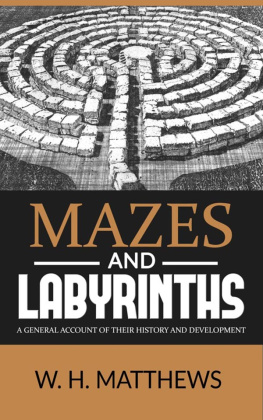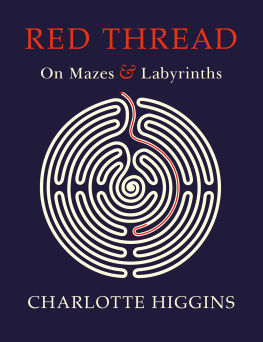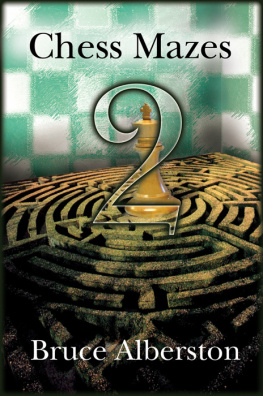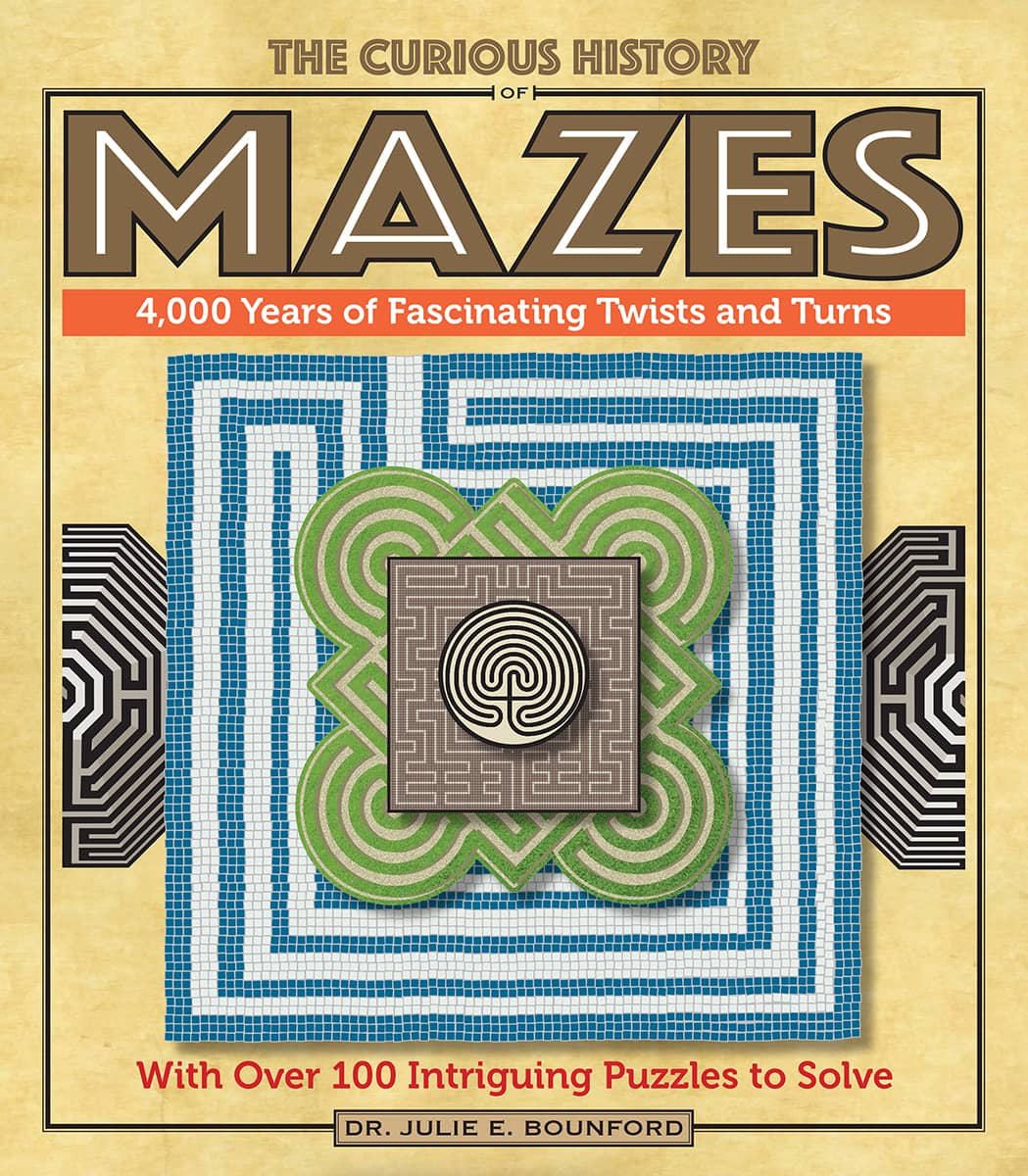CONTENTS
Guide
INTRODUCTION
All Mathematics would suggest
A steady straight line as the best,
But left and right alternately
Is consonant with History.
from The Labyrinth by W.H. Auden
T he curious history of mazes does not run in a steady straight line, but, instead, begins with the labyrinth: a simple motif that is no doubt familiar to us all. With its true origins still shrouded in mystery, the chronicle of the labyrinth, and more recently of the maze, spans the past four thousand years, taking many twists and turns. This book introduces archetypes that have emerged over the centuries, serving different symbolic, ritualistic, and practical purposes worldwide. As such, the labyrinth is embedded in our psyche as a powerful symbol of the human experience, and in this book we examine form, function, fulfillment, and fun. There are many intriguing aspects to this marvelous history. Not least that the very word maze, which is so often used interchangeably with labyrinth, is not as old as its companionalthough both have multiple derivations.
The Roman poet Virgil, in 2919 BCE, brings them together in The Aeneid and describes the labyrinth as having, a path woven with blind walks. It is a bewildering work of craft with a thousand ways where the tokens of the course were confused by the indiscoverable and irretraceable maze. A seminal work of Western literature, this poem is imbued with labyrinthine leitmotif in its narrative structure, imagery, and ideas. It brings together themes such as ambiguity, confusion, uncertain choices, and the search for a clear path. Much later, in Geoffrey Chaucers Canterbury Tales (13871400 CE) we find examples of early English usage that also combine these themes. People are in a state of masednesse. That is, they are puzzled or bewildered: Ye mase, ye masen goode sire, quod she, This thank have I for I have made to you. (The Merchants Tale).
With this curious history I do not aim to mase, but I do invite you to explore the evolution of labyrinths and mazes through time and across continents. There are some surprises along the way as we reinterpret historical artifacts such as Arthur Bernard Deacons 1926 labyrinthine illustration of a turtle sand drawing from the island of Malekula in the New Hebrides. You are also invited to solve many puzzles included throughout the following pages, in which some famous mazes are reproduced, so there is no need to travel to Chartres in France or Hampton Court Palace in England. They are here in this book, drawn by illustrator Trevor Bounford, for you to contemplate, trace, and solve at your leisure, time and time again if you like, along with other well-known examples. I also present a collection of new puzzle mazes created exclusively for this book. The levels of difficulty vary and suit a wide range of abilities. You are invited to tackle one and all, and in doing so you may wish to consider the advice of English maze master, Greg Bright, who writes in his groundbreaking 1973 Maze Book:
I suggest the best way to follow the paths is with the aid of a match-stick. The reader will probably get the most out of a maze by treating his journey as if he were walking it, refraining from jumping back to the start and from one point to another, and from trying with his eyes to work the route back from the end. A method that prevents accidentally crossing lines is to place tracing paper over the maze and mark in your journey. An experiment one can try is to make a small hole in the center of a large sheet of paper, place the paper over the maze and follow the route using this restricted view. This method makes exploring the maze closer to actually walking it.
Mazes are for those who want to tune in to their innate sense of curiosity. Meditate, learn, and reconnect with your sense of fun.
Explore the Curious History of Mazes
Start to build your knowledge of an extraordinary global phenomenon. This curious history draws upon a wealth of historical and classical literature; accounts written by explorers, archaeologists, historians; and the output of modern and contemporary world-renowned experts and enthusiasts including (and especially) Jeff and Kimberly Saward, Michael Ayrton, Greg Bright, Janet Bord, Hermann Kern, Robert Ferr, the Reverend Dr. Lauren Artress, Sig Lonegren, Jill Purce, Adrian Fisher, Randoll Coate, Geoffrey Ashe, Jim Buchanan, Giovanni Mariotti, and Francesca Tatarella.
The Sawards, cofounders of Labyrinthos (an online Labyrinth Resource Center, photo library, and archive), justifiably claim that labyrinth literature has long been riddled with error, exaggeration, and romantic speculation. This book introduces a complex history, citing thoughts and theories while echoing some of the prevailing mysteries.
Give Yourself the Time and Space that You Deserve
Allow time to explore the beauty and benefits of labyrinths and mazes as instruments of self-discovery, transformation, and fulfillment. Taken as a powerful metaphor for lifes journey, labyrinths and mazes can be used today as tools for meditation and learning at any level, even when completed as a recreational pastime.
Take a Journey
Journey not to escape but rather move toward a deeper understanding of the challenges that you face, be they small or large. This is not about running away. Labyrinths and mazes emulate life, and as with life, the road is never straight. At your own pace, use each twist and turn to pause and reflect on where you are and where you may be heading. Sometimes it is necessary to choose a different path, and the ultimate destination may, or may not be, the same as when you started. Perhaps your intentions are true, but you need to reconsider how to approach them.
Reconnect with Your Authentic Self
Gain a greater sense of self-awareness as you move toward the goal. Use the side-to-side motion of the labyrinth to ease yourself, back and forth, into a realignment of your perspective. Seek fresh insight into a particular challenge, make a decision or choice, let go of an issue or person, heal emotional wounds, or set new goals. To tackle all these and more, you need to reconnect with your authentic self and be true to your core values.
Have Fun
A brainteaser or simple mental stimulus may be all that you are looking for to relax. Getting lost or disorientated and then finding your way can be great fun. It does not always have to be a journey to self-awareness, although it is surprising what you learn about yourself along the way. Use this book as an introduction to the wonderful world and history of labyrinths and mazes, and as a tool for discovery and play.
The book begins in chapter one by focusing on the origins and definitions of mazes and labyrinths. We will see that throughout their legends and long history mazes and labyrinths refuse to conform to any rudimentary definition. Chapter two focuses on the classical maze and examines Roman and Greek artifacts. In chapter three we consider the spiritual perspectives in which labyrinths have been given a metaphysical or sacred status in different cultures that takes us beyond the natural world. In chapter four we see the expansion of the Christian interpretation, and in chapter five we learn about folklore and communal traditions of the rustic maze.








